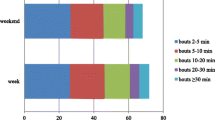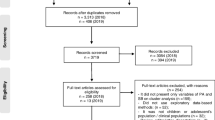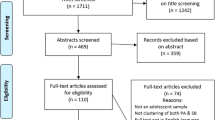Abstract
The purpose of this study was to use ecological momentary assessment to investigate the patterning of physical activity and sedentary behaviours in UK adolescents and to examine if different lifestyle groups differ on key explanatory variables. A total of 1,371 (38% boys, mean age 14.7 years) adolescents completed diaries every 15 min for 3 weekdays outside of school hours and 1 weekend day. Cluster analysis yielded five-cluster solutions for both boys and girls to explain the grouping of sedentary behaviours and physical activity. The clusters demonstrated that adolescents engage in many leisure time behaviours but have one activity that predominates. Active adolescents spend more time outside and more time with their friends. Few demographic and environmental variables distinguished between clusters. The findings suggest a potential need for different behavioural targets in interventions to reduce sedentary behaviour in sub groups of the adolescent population. Further research is required to examine the modifiable determinants of different sedentary lifestyles among young people.


Similar content being viewed by others
References
American Academy of Pediatrics (2001). Policy statement: Children, adolescents and television (RE0043). Pediatrics, 107(2), 423–426.
Baranowski, T. (1985). Methodologic issues in self-report of health behavior. Journal of School Health, 55(5), 179–182.
Department for Education and Skills (2004). Statistics of education: Schools in England 2004 edition. Retrieved 26 July 2005 from http://www.dfes.gov.uk/rsgateway/DB/VOL/v000495/schools_04_final.pdf
Department of Health (2004). At least five a week: Evidence of the impact of physical activity and its relationship to health. A report from the Chief Medical Officer. Retrieved from http://www.dh.gov.uk/PublicationsAndStatistics/Publications/PublicationsLibrary/fs/en
Department of Health and Ageing (2005). Australia’s physical activity recommendations for children and young people. Retrieved 19 September 2006 from http://www.health.gov.au
Dunton, G., Whalen, C., Jamner, L., Henker, B., & Floro, J. (2005). Using ecologic momentary assessment to measure physical activity during adolescence. American Journal of Preventive Medicine, 29(4), 281–287.
Epstein, L. H., & Roemmich, J. N. (2001). Reducing sedentary behaviour: Role in modifying physical activity. Exercise and Sport Sciences Reviews, 29, 103–108.
Field A. (2005). Discovering statistics using SPSS (2nd edn.). London: Sage.
Gordon-Larsen, P., McMurray, R. G., & Popkin, B. M. (2000). Determinants of adolescent physical activity and inactivity patterns. Pediatrics, 105, 1–8.
Gorely, T., Marshall, S., & Biddle, S. (2004). Correlates of TV viewing in adolescents. International Journal of Behavioural Medicine, 11, 152–163.
Gorely, T., Marshall, S., Biddle, S., & Cameron, N. (in press). The prevalence of leisure time sedentary behaviour and physical activity in adolescent girls: An ecological momentary assessment approach. International Journal of Pediatric Obesity.
Hair, J. F., Black, W. C., Babin, B. J., Anderson, R. E., & Tatham, R. L. (2006). Multivariate data analysis (6th edn.). Upper Saddle River, NJ: Pearson Prentice Hall.
Heath, E., Coleman, K., Lensegrav, T., & Fallon, J. (2006). Using momentary time sampling to estimate minutes of physical activity in physical education: Validation of scores for the system for observing fitness instruction time. Research Quarterly for Exercise and Sport, 77(1), 142–146.
Henning Broderson, N., Steptoe, A., Williamson, S., & Wardle, J. (2005). Sociodemographic, developmental, environmental, and psychosocial correlates of physical activity and sedentary behavior at age 11 to 12. Annals of Behavioral Medicine, 29(1), 2–11.
Marshall, S. J., Biddle, S. J. H., Sallis, J. F., McKenzie, T. L., & Conway, T. L. (2002). Clustering of sedentary behaviours and physical activity among youth: A cross-national study. Pediatric Exercise Science, 14, 401–417.
Marshall, S., Gorely, T., & Biddle, S. (2006). A descriptive epidemiology of screen based media use among youth: A review and critique. Journal of Adolescence, 29, 333–349.
Murray, D., Catellier, D., Hannan, P., Treuth, M., Stevens, J., Schmitz, K., Rice, J., & Conway, T. (2004). School-level intraclass correlation for physical activity in adolescent girls. Medicine and Science in Sports and Exercise, 36(5), 876–882.
Nelson, M., Gordon-Larsen, P., Adair, L., & Popkin, B. M. (2005). Adolescent physical activity and sedentary behavior: Patterning and long-term maintenance. American Journal of Preventive Medicine, 28(3), 259–266.
Sallis, J., & Owen, N. (2002). Ecological models of health behavior. In K. Glanz, B. Rimer, & F. Marcus Lewis (Eds.), Health behavior and health education (pp. 462–484). Jossey-Bass: San Francisco.
Sallis, J., Prochaska, J., & Taylor, W. (2000). A review of correlates of physical activity of children and adolescents. Medicine and Science in Sports and Exercise, 32, 963–975.
Saudargas, R. A., & Zanolli, K. (1990). Momentary time sampling as an estimate of percentage time: A field validation. Journal of Applied Behavior Analysis, 23, 533–537.
Schmitz, K. H., Lytle, L. A., Phillips, G. A., Murray, D. M., Birnbaum, A. S., & Kubik, M. Y. (2002). Psychosocial correlates of physical activity and sedentary leisure habits in young adolescents: The teens eating for energy at school study. Preventive Medicine, 34(2), 266–278.
Smyth, J., & Stone, A. (2003). Ecological momentary assessment research in behavioral medicine. Journal of Happiness Studies, 4, 35–52.
Stone, A., & Shiffman, S. (2002). Capturing self-report data: A proposal for reporting guidelines. Annals of Behavioral Medicine, 24(3), 236–243.
Summerbell, C. D., Ashton, V., Campbell, K. J., Edmunds, L., Kelly, S., & Waters, E. (2004). Interventions for treating obesity in children (Cochrane Review). Chichester: John Wiley.
Tabachnick, B. G., & Fidell, L. S. (2007). Using multivariate statistics (5th edn.). Boston, MA: Pearson Allyn & Bacon.
Welk, G., Corbin, C., & Dale, D. (2000). Measurement issues in the assessment of physical activity in children. Research Quarterly for Exercise and Sport, 71(2), 59–73.
Author information
Authors and Affiliations
Corresponding author
Rights and permissions
About this article
Cite this article
Gorely, T., Marshall, S.J., Biddle, S.J.H. et al. Patterns of Sedentary Behaviour and Physical Activity Among Adolescents in the United Kingdom: Project STIL. J Behav Med 30, 521–531 (2007). https://doi.org/10.1007/s10865-007-9126-3
Received:
Accepted:
Published:
Issue Date:
DOI: https://doi.org/10.1007/s10865-007-9126-3




